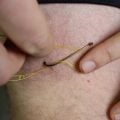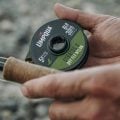How to Tie a Night King
Producer: Tim Flagler
“I call this fly the Night King, although it’s really nothing more than a Frenchie, tied using less than traditional colors. Over the years, I’ve found that flies that incorporate the color blue work exceptionally well during the winter months. I’m sure there’s some kind of scientific rationale for this, but I’m going solely on my own experience.
For a hook, a Lightning Strike JF2 in size 14 is a good choice. For those of you unfamiliar with jig hooks, many of them are barbless with elongated points, and all incorporate a bend, generally around 60 degrees, located a short distance behind the hook eye. Slotted beads are usually used in conjunction with jig hooks, here, I’m using one made out of tungsten that’s 7/64” in diameter, with a black nickel finish. The slot on these beads is specifically designed to go on the bent shank of the jig hook. The slot has a square end as well as a curved one.
Begin by inserting the point of the hook into the small hole of the bead, on the opposite side from the slot. Work the bead around so it rests behind the hook eye. The rounded end of the slot should be on top of the hook shank. Get the assembly firmly secured in the jaws of your tying vise.
For thread, I’m going to use UTC 70 Denier in fluorescent pink. Get the thread started on the hook shank behind the bead and, after 10 or so touching wraps rearward, snip off the excess tag. Advance your thread forward to just behind the bead. Check once again to make sure the round end of the slot, not the square end, is on top of the hook shank. If not, the bead won’t sit correctly behind the eye of the hook.
.02 lead-free wire is used to add weight, to stabilize the bead and add some taper to the body of the fly. With the wire still on the spool, insert the end into the bead slot and take nice tight thread wraps to secure it. This will help to brace the bead against the back of the hook eye. Start taking wraps with the wire, behind your tying thread. Pushing up on the thread will help to keep the wire wraps sandwiched close together. After 6 or 7 turns, use your tying thread to anchor the wire to the top of the hook shank, then bend the wire up and down as you take thread wraps rearward. When the wire breaks, you should be left with a ramp down to the hook shank. Take wraps of tying thread over the wire and up to the bead to further secure the wire. End with your tying thread at about the hook point.
Silver Doctor blue saddle hackle fibers are used to form the tail of the fly. Look for a feather like the one on the bottom, with fibers that have little to no web in by the stem. Webby fibers, like those on the top feather, are generally too soft for tailing material. Isolate 8-10 nice, straight fibers and preen them down, perpendicular to the stem. Get hold of their tips and pull the stem away from the fibers to strip them free. Aligning the butts of the fibers will align their tips as well. Measure to form a short tail, just a little more than a hook gap in length, and transfer that measurement to the start of the hook bend. I prefer to trim the butt ends off prior to tie-in. You can use the back end of the wire wraps as a guide for your scissors, then snip the butt ends off square.
Place the fibers straight down on top of the hook shank and give your bobbin a good counterclockwise spin, from the perspective of looking down on it. This will cause the thread to jump rearward during the first wrap and catch the very butt ends of the hackle fibers. Continue taking thread wraps rearward, pulling slightly up and towards you on the fibers. Doing this will keep them on top of the hook shank, as opposed to being pushed to the far side of the hook by the thread wraps. When you reach the bend of the hook, check to make sure the tail looks ok, then take touching wraps forward with your tying thread until it hangs just in front of the hook point.
Medium blue Sulky Holoshimmer, which is available online and at better craft stores, is used for the rib of the fly. An 8” length is enough to make a small army of Night Kings. Lay one end of the material against the near side of the hook and take thread wraps to secure it. It’s pretty slippery stuff so make sure it’s bound down well, all the way to the base of the tail. Once again advance your tying thread forward, until it hangs at about the hook point.
Like the Frenchie, the body of the Night King is created using pheasant tail fibers. You can use naturally colored ones if you like, but I prefer ones that have been dyed black. It, like the color blue, seems to work well during the winter months. Pheasant tail feathers generally have a webby side and a side with stiffer, longer fibers. Choose the latter for producing the bodies of flies. Pull down 10-12 fibers perpendicular to the stem then pull the stem away to free the fibers. It’s a good idea to snip the curly butt ends off, as they tend to catch on things, particularly tying thread. Flip the fibers around to hold the tips in the fingers of your left hand, then snip just those very tips off square.
Place the fibers against the near side of the hook, so the snipped-off tips abut the wire wraps. Once again, give your bobbin a counterclockwise spin so the first wrap jumps rearward to catch the tips. Continue taking thread wraps rearward to anchor the fibers to the hook shank, all the way back to the base of the tail, and this time leave your tying thread right there. Start taking forward-touching wraps with the fibers behind your tying thread. Here again, pushing the tying thread up will help to keep the pheasant tail fibers sandwiched close together. Keep wrapping with the fibers as far up the hook shank as you can. Then take wraps of tying thread to bind them down. With the fibers bound down really well, reach in with your tying scissors and snip the excess butt ends off close.
Get hold of the blue Holoshimmer material and start making counter wraps with it over top of the pheasant tail body. These counter wraps will not only rib and segment the fly, but will also help to protect the delicate pheasant tail fibers below. When you reach the bead, take a couple of turns with the Holoshimmer around the shank, then take wraps of tying thread to lock the material down. Once it’s completely anchored, snip the excess off close. The fly should now look something like this.
Although you can use blue Ice dub for the collar of the fly, I really like peacock blue Antron dubbing, because of its shimmer, translucency and dubability – if that’s a word. Using only small wisps at a time, create a slender inch-and-a-half long noodle on your tying thread. As is so often the case with dubbing, less is more. Start taking wraps with the noodle to build up a short collar behind the bead. Continue taking thread wraps with the pink thread to form a narrow little band, or hot spot, behind the bead. Try not to overdo it. Thin bands generally look better than thick.
Reach for your whip finish tool and use it to do a 4 or 5 turn, back to front, whip finish, then seat the knot well and snip or cut your tying thread free. Thread collars like these are the most vulnerable part of this type of fly. A drop of head cement, or here Sally Hansen Hard as Nails, applied to the wraps will greatly increase durability. Once the adhesive sinks in and dries, the Night King is ready for battle.
You may want to tie up a bunch of these, Winter is Coming.”
How to Tie a Near Nuff Sculpin | Simple Small Streamer
How to Tie a Non-Slip Loop Knot











